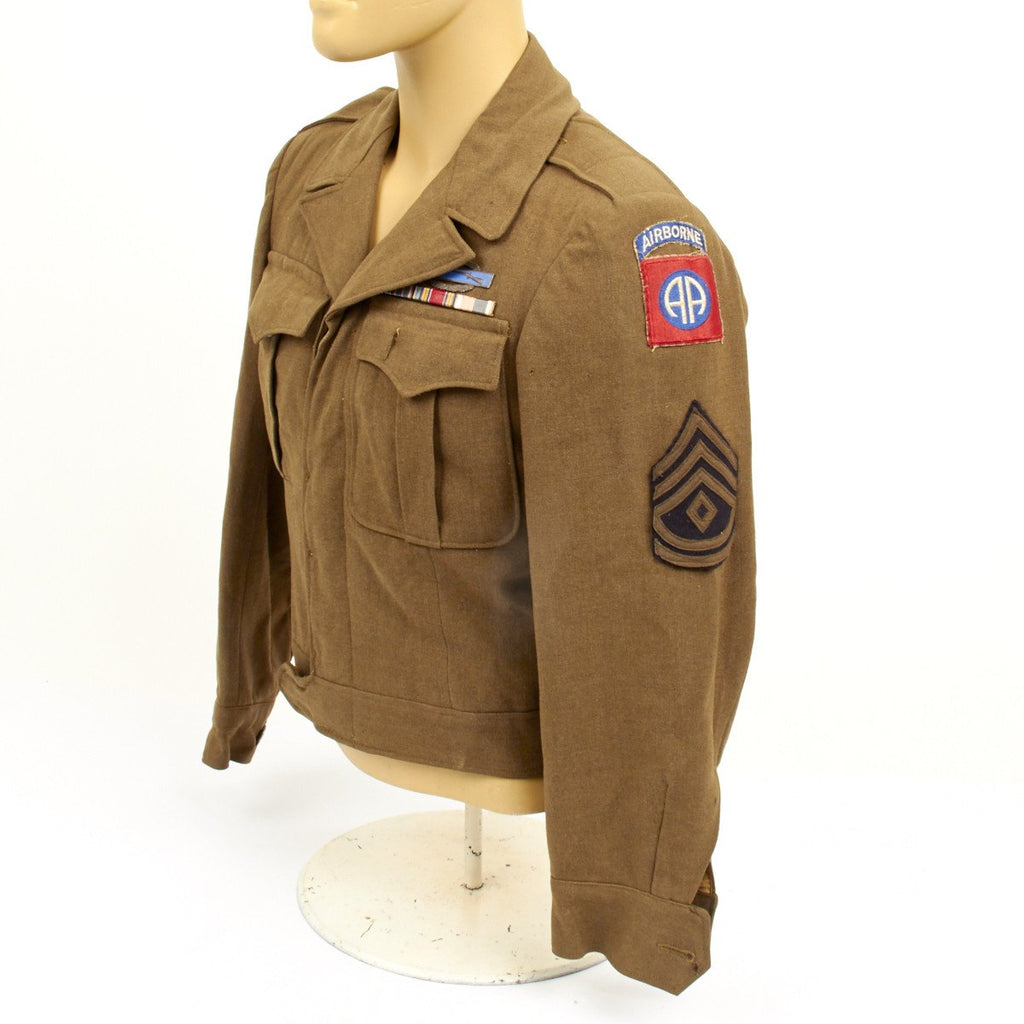Item Description
Original Item: Only One Available:. This is a very nice condition size 36 WW2 Ike jacket worn by a member of the 82nd Airborne. This soldier, jacket is not named, served in the 82nd Airborne All American Division was decorated with the following awards:
American Campaign Medal Ribbon
WWII Victory Medal Ribbon
WWII army of occupation Medal Ribbon
WWII 82nd Airborne Divison:
The 82nd Division was redesignated on 13 February 1942 as Division Headquarters, 82nd Division. It was recalled to active service on 25 March 1942, and reorganized at Camp Claiborne, Louisiana, under the command of Major General Omar N. Bradley. During this training period, the division brought together four officers who would ultimately steer the United States Army during the following two decades: Matthew B. Ridgway, Matthew D. Query, James M. Gavin, and Maxwell D. Taylor who became the commander of the 101st Airborne Division in 1944. This was following Bill Lee's heart attack. Under General Bradley, the 82nd Division's Chief of Staff was George Van Pope. The Allied invasion of Sicily was originally to be kept a secret.
On 15 August 1942, the 82nd Infantry Division became the first airborne division of the United States Army, and was redesignated as the 82nd Airborne Division. In April 1943, its paratroopers deployed to North Africa under the command of Major General Matthew B. Ridgway to take part in the campaign to invade Italy. The division's first two combat operations were parachute assaults into Sicily on 9 July and Salerno on 13 September 1943. The initial assault on Sicily, by the 505th Parachute Infantry Regiment, was the first regimental-sized combat parachute assault conducted by the United States Army. The first glider assault did not occur until Operation Neptune as part of D-Day. Glider troopers of the 319th and 320th Glider Field Artillery battalions and the 325th Glider Infantry Regiment instead arrived in Italy by landing craft at Maiori (319th) and Salerno (320th, 325th).
In January 1944, the 504th Parachute Infantry Regiment, which was temporarily detached to fight at Anzio, adopted the nickname "Devils in Baggy Pants", taken from an entry in a German officer's diary. The regiment was replaced in the division by the 507th Parachute Infantry. While the 504th was detached, the remainder of the 82nd Airborne moved to the United Kingdom in November 1943 to prepare for the liberation of Europe. See RAF North Witham and RAF Folkingham.
Normandy
With two combat assaults under its belt, the 82nd Airborne Division was now ready for the most ambitious airborne operation of the war so far, as part of Operation Neptune, the invasion of Normandy. The division conducted Operation Boston, part of the airborne assault phase of the Operation Overlord plan.
In preparation for the operation, the division was reorganized. To ease the integration of replacement troops, rest, and refitting following the fighting in Italy, the 504th PIR did not rejoin the division for the invasion. Two new parachute infantry regiments (PIRs), the 507th and the 508th, provided it, along with the 505th, a three-parachute infantry regiment punch. On 5 and 6 June, these paratroopers, parachute artillery elements, and the 319th and 320th, boarded hundreds of transport planes and gliders to begin history's largest airborne assault at the time (only Operation Market Garden later that year would be larger). During the June 6th assault, a 508th platoon leader, Lieutenant Robert P. Mathias, would be the first U.S. Army officer killed by German fire on D-Day On June 7, after this first wave of attack, the 325th Glider Infantry Regiment would arrive by glider to provide a division reserve.
By the time the All-American 82nd Airborne Division was pulled back to England, it had seen 33 days of bloody combat and suffered heavy losses, with 5,245 troopers killed, wounded, or missing. Ridgway's post-battle report stated in part, "... 33 days of action without relief, without replacements. Every mission accomplished. No ground gained was ever relinquished."[9]
Following Normandy, the 82nd Airborne became part of the newly organized XVIII Airborne Corps, which consisted of the U.S. 17th, 82nd, and 101st Airborne Divisions. Ridgway was given command, but was not promoted to lieutenant general until 1945. His recommendation for succession as commander was Brigadier General James M. Gavin. Ridgway's recommendation met with approval, and upon promotion Gavin became the youngest general since the Civil War to command a U.S. Army division.
- This product is available for international shipping.
- Eligible for all payments - Visa, Mastercard, Discover, AMEX, Paypal & Sezzle














